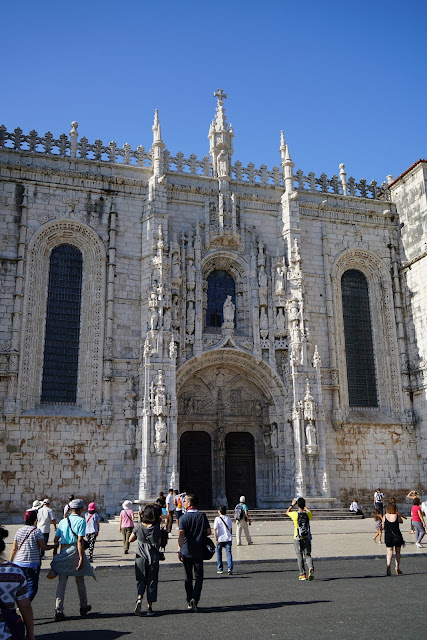It was a group of magnificent buildings built and renovated repeatedly between 1501 right up to 2002, surviving many dynasties and changes of government. Originally, it was the old Hermitage of Restelo (Ermida do Restelo) dedicated to Santa Maria de Belém, where the monks of the military-religious Order of Christ helped protect seafarers in transit in the harbour of Praia do Restelo close by. It was in disrepair in 1497 when Vasco da Gama prayed there before embarking on his perilous sea journey to India. The idea for the new monastery was that of King Manuel I (1469-1521). He intended it as the final resting place for members of the house of Aviz.
,
The fountain in the Praça do Império in front of the Geronimo Monastery
The fountain in the Praça do Império in front of the Geronimo Monastery

The late Gothic Portuguese Maneuline style main south portal, which forms the entrance of Monastery the century-long construction of which started in 1501. The building costs came from a tax called Vintena da Pimenta, a 5 percent tax on commerce from Africa and the
Orient, equivalent to 70 kg of gold each year( in addition to direct taxes imposed on the importation of pepper,
cinnamon and cloves). King Manuel
I chose the religious order of Hieronymite monks to occupy the
monastery and charged them with the duty of praying for the King's eternal soul and to
provide spiritual assistance to navigators and sailors who left the port of Restelo close by to discover lands around the world.The monks
did so for over four centuries. They stopped doing so in 1833 when the religious orders were
dissolved following the the success of a liberal and anti-clearical government and the monastery was abandoned. On 28 December 1833, the Jerónimos Monastery was secularised by state decree. Its title was transferred to the Real Casa Pia de Lisboa (Pious Royal House of Lisbon) to serve as a parochial church for the new civil parish of Santa Maria de Belém.

A closer view of the front gates, designed by Juan de Castilho and built with a special type of gold-colored limestone called calcário de lioz from Ajuda,
the valley of Alcántara, Laveiras, Rio Seco and Tercenali of Portugal. In the middle between the two gates is the statue of Prince Henry the Navigator.
The statue on the right of the entrance
The statue on the left of the entrance
The roof of the vault inside the entrance
The tomb of Vasco da Gama. da Gama (1460s-1524) whose discovery of the sea route to India enabled Portuguese traders to avoid the previous more dangerous North and West African trade routes and to establish a long lasting empire in Asia more than a century before the Dutch the the English did do and to avoid having to sail through the highly contested Mediterranean and the dangerous Arabian Peninsula. He first landed in Calicut on 20th May 1498. The spices obtained from Southeast Asia were primarily pepper and cinnamon at first, but soon included other products, all new to Europe. Portugal maintained a commercial monopoly of these commodities for several decades. He led the first and fourth expeditions to India. It was Da Gama who led two of the Portuguese armadas destined for India, the first and the fourth. The latter was the largest and departed for India four years after his return from the first. For his contributions, Da Gama was appointed the Governor of India in 1524, under the title of Viceroy, and given the newly created County of Vidigueira in 1519. Vasco da Gama remains a leading figure in the history of exploration. The Portuguese national epic, Os Lusíadas, was written in his honour. His first trip to India is widely considered a milestone in world history, .
The main chapel with its high slim but intricately carved Gothic columns and vaulted roof
One of the candelabras, now using electric light
an elaborate stained glass window
Another one
a statue of the Holy Mother
One of the tombs of the king supported by two elephants. In the royal pantheon; four of the eight
children of John IV of Portugal were entombed: including Infante Teodósio
(1634–1653), the Infanta Joana (1636–1653), King Afonso VI (1643–1683)
and Catarina de Bragança (1638–1705)

The windows above the tomb

Many of the decorations were done with gold
One of the side alters, decorated in silver
Another one done in gold
Mary and Joseph with the infant Jesus
Another statue of the Mother and Child
The stained glass window on the other side of the chapel
Another stained glass window of the Holy Mother with Child. Mary probably played the same role for Portuguese sailors as the Koon Yin for Chinese sailors.
A cross in the middle of the balcony
Another stained glass window close to the entrance
The tomb of Luís de Camões,( Camoens or Camoëns( c
1524 or 1525 – 1580), Portugal's and the
Portuguese language's greatest poet. His mastery of verse has been
compared to that of Shakespeare, Vondel, Homer, Virgil and Dante. He
wrote a considerable amount of lyrical poetry and drama but is best
remembered for his epic work Os Lusíadas (The Lusiads)
Another golden death. Different parts of annex to the Monastery are now used respectively as The Maritime Musuem (Meseu da Marinha) (from 1909 on) and another part as Calouste Gulbenkin Planetary (since 1962). Below is a U-tube video of the Maritime Museum which we did not have enough time to see.:






















沒有留言:
張貼留言